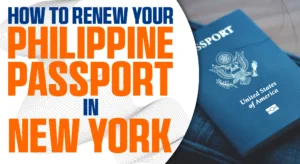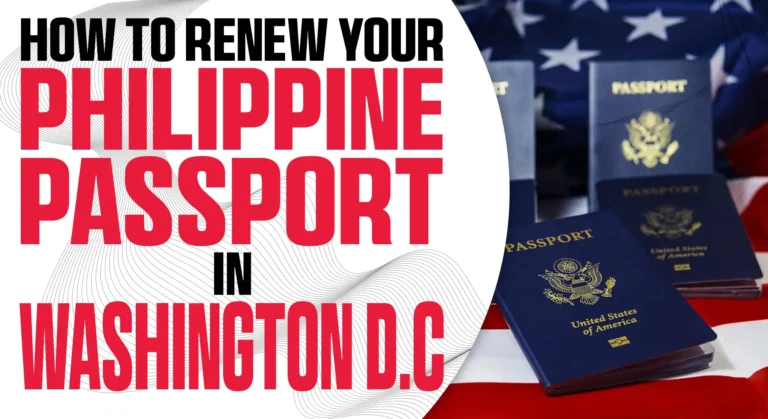How to Renew Your Philippine Passport in New York
Renew your Philippine passport in New York with our guide. Covers appointments , required documents , $60 fee , processing , and tips for the NY PCG. Plan ahead!

The Philippine passport serves as a vital document for Filipino citizens, affirming their identity and nationality, and facilitating international travel. For Filipinos residing within the consular jurisdiction of the Philippine Consulate General (PCG) in New York, understanding the renewal process is paramount. This guide offers an in-depth examination of the procedures, requirements, and important considerations for successfully renewing a Philippine passport through the New York PCG, drawing upon official information to ensure accuracy and clarity. The PCG in New York stands as a critical service point, and being well-prepared can significantly streamline the renewal experience.
Locating and Contacting the Philippine Consulate General (PCG) in New York
The Philippine Consulate General in New York is the official diplomatic mission responsible for providing consular services, including passport renewal, to Filipinos in its designated areas of responsibility.
Physical Address and Contact Information:
The New York PCG is located at: 556 5th Avenue New York, New York 10036
Key contact details are:
- Telephone: (212) 764-1330
- Fax: 00-1212-382-1146
- Email: newyork@pcgny.net
- Official Website: https://newyorkpcg.org/pcgny/
Consular Jurisdiction:
The New York PCG serves a wide region, encompassing the following U.S. states: Connecticut, Delaware, Maine, Massachusetts, New Hampshire, New Jersey, New York, Pennsylvania, Rhode Island, and Vermont. The extensive nature of this jurisdiction underscores the volume of consular activities, including passport services, handled by this post. Applicants residing in these states should direct their passport renewal applications to the New York PCG.
The official website is an indispensable resource, providing the most current information, forms, and advisories. It is strongly recommended that applicants consult the website thoroughly before initiating the renewal process.
Preparing Your Application: Core Requirements for ePassport Renewal (Adults 18+)
The renewal of a Philippine ePassport for adult applicants (18 years and older) follows a structured process with specific documentary requirements. Adherence to these requirements is crucial for a smooth application.
Mandatory Appointment:
An appointment is required for passport renewal services. This system is fundamental to managing the flow of applicants at the Consulate, preventing excessive wait times and ensuring that consular staff can allocate sufficient attention to each individual. In a high-demand post like New York, such a system is essential for operational efficiency and a more predictable applicant experience, though it necessitates advance planning by the applicant. Appointments are booked through the centralized portal: http://www.passport.gov.ph.
Core Documentary Requirements:
For a standard ePassport renewal for individuals aged 18 and above, the following basic documents must be prepared:
- Printed Passport Application Packet with a barcode: This packet is typically generated from the online appointment system. The barcode is indicative of a centralized data capture system, likely managed by the Department of Foreign Affairs (DFA) in Manila. This approach means initial data is entered electronically, streamlining the process upon arrival at the Consulate as basic information and appointment details are already in the system. This reduces manual data entry on-site and can expedite per-applicant processing.
- Original current Philippine ePassport and one (1) photocopy of its data page: The data page is the page containing the applicant’s photograph and biographical information.
- Original and one (1) photocopy of Proof of Filipino Citizenship: The Consulate provides a link on its website (
https://newyorkpcg.org/pcgny/consular-services/passport/#proof-filipino) detailing the accepted documents for this purpose. Applicants must consult this specific page to ascertain the current list of acceptable proofs, which often includes documents such as a PSA-authenticated Birth Certificate or the previous passport if acquired by birth.
The process places a degree of reliance on the applicant’s ability to navigate online systems for booking appointments and potentially for completing the initial application form that yields the barcoded packet. This implies an expectation of digital literacy, shifting some responsibility to the applicant to prepare using these online resources, thereby reducing the need for preliminary visits to the Consulate for forms or basic information.
Core ePassport Renewal Requirements (Adults 18+)
| Document Name | Specifics/Notes |
| Printed Passport Application Packet | Must have a barcode; typically generated from the online appointment system. |
| Original Current Philippine ePassport | |
| Photocopy of Current Philippine ePassport Data Page | One (1) copy. |
| Original Proof of Filipino Citizenship | Refer to the PCG New York website via the link provided in for the list of accepted documents. |
| Photocopy of Proof of Filipino Citizenship | One (1) copy. |
Additional Documentation and Procedures
While the core requirements cover straightforward ePassport renewals, many applicants will encounter situations necessitating additional documentation. These circumstances often involve changes in civil status or corrections to passport data, and almost invariably require documents authenticated by the Philippine Statistics Authority (PSA). This reliance on PSA-authenticated documents underscores a critical aspect of the Philippine legal framework: changes to an individual’s official civil status must be recorded within the Philippine civil registry system before they can be reflected in national identification documents like the passport. Foreign-issued documents, such as a U.S. marriage certificate or divorce decree, are generally not sufficient on their own; they often need to be officially reported to Philippine authorities (e.g., Report of Marriage) or legally recognized within the Philippine system (e.g., judicial recognition of foreign divorce) and subsequently recorded by the PSA. The PCG in New York acts as a gatekeeper in this regard, ensuring that passport amendments align with official Philippine records.
Renewing Non-Electronic Passports:
For applicants holding older, non-electronic passports (such as Brown, Green, or Machine-Readable Maroon Passports), the renewal process is treated as a new application. Consequently, the requirements for a first-time applicant must be submitted. This is a significant distinction, as it typically involves more extensive documentation beyond a simple renewal, often requiring foundational proofs of citizenship like a PSA Birth Certificate and other supporting identification.
For Newly Married Females Opting to Use Husband’s Surname:
Applicants in this category must submit:
- Original and one (1) photocopy of a PSA-authenticated Marriage Certificate or Report of Marriage (ROM). A link to request PSA-authenticated certificates (
https://www.psaserbilis.com.ph/Default.aspx) is often provided by consular websites. - A Local Civil Registrar (LCR) copy of the Marriage Certificate may be required if the PSA copy is unclear or unreadable.
- Importantly, if a female applicant chooses to retain her maiden name, a Marriage Certificate is not required.
The emphasis on “PSA-authenticated” is crucial. A Report of Marriage is applicable if the marriage occurred abroad and was duly reported to a Philippine Embassy or Consulate.
For Female Applicants Whose Marriage Has Been Dissolved and Wish to Revert to Maiden Surname:
Reverting to a maiden surname after marriage dissolution requires specific proof:
- A copy of the original annotated PSA-authenticated Marriage Certificate (MC) or Report of Marriage (ROM) explicitly stating that the marriage has been dissolved. An “annotated” document signifies that the original civil registry record in the Philippines has been officially updated to reflect the change in marital status.
- Alternatively, if an annotated MC or ROM from the PSA is not yet available, the applicant must submit a Certified True Copy of the Court Order dissolving the marriage and a Certificate of Finality from the court.
This process can be lengthy, as obtaining an annotated PSA document involves legal and administrative steps in the Philippines.
If an Applicant Wants to Correct Data on Their Passport:
Data corrections also necessitate official documentation:
- Discrepancy in first name: A copy of the petition and supporting documents for correction of the first name filed with the Local Civil Registrar (LCR) or the relevant Philippine Embassy/Consulate.
- Discrepancy in other data (e.g., birth date, birthplace): An annotated birth certificate authenticated by the PSA reflecting the corrected entry.
Changing the Format of Your Married Name:
For married women already using their husband’s surname in their passport but wishing to change its format, specific rules apply. A married woman may use her husband’s surname in one of two formats:
- (First name) + (Maiden surname as middle name) + (spouse’s last name)
- (First name) + (Maiden middle name) + (Maiden surname) + (-) + (spouse’s last name)
To switch between these formats (if one is already reflected in her latest passport), she must present:
- At least one (1) valid identification card.
- PSA-authenticated Certificate of Live Birth, Report of Birth, or Certificate of Foundling.
- PSA-authenticated Certificate of Marriage or Report of Marriage.
- A notarized affidavit explaining why she has opted to change the format of her married name.
Reversion to Maiden Name (Other Circumstances):
Beyond marriage dissolution, other situations allow for reversion to maiden name:
- By virtue of death of the spouse:
- PSA-authenticated Certificate of Death or Report of Death (ROD) of the spouse, or an apostilled or authenticated Foreign Death Certificate of a foreign spouse (with English translation, if applicable).
- PSA-authenticated Certificate of Live Birth or Report of Birth of the applicant.
- Latest issued Philippine passport (if available).
- By virtue of an annulment, declaration of nullity of marriage, judicially-recognized foreign divorce, etc.: This largely overlaps with point C, requiring a PSA-authenticated Marriage Certificate or Report of Marriage with an annotation reflecting the marriage’s nullity or dissolution, along with a PSA-authenticated birth certificate and the latest passport.
- Reasons apart from those stated above (can only be done once):
- PSA-authenticated Certificate of Live Birth or Report of Birth.
- A notarized Affidavit of Explanation that includes a request for the reversion to maiden name in the Philippine passport and states that she has not previously availed of this specific provision for reversion.
- Latest-issued Philippine passport. This one-time option provides flexibility under circumstances not covered by death or legal dissolution of marriage.
The consistent requirement for PSA-authenticated documents, particularly annotated ones or those tied to legal proceedings, can significantly extend the preparation timeline and potentially increase costs for applicants before they even submit their passport renewal application. This “hidden time cost” is a critical factor for applicants in these special categories to consider. Furthermore, the variety of these scenarios and their nuanced documentation needs (e.g., “annotated” vs. regular PSA certificate, the dual requirement of a court order and a certificate of finality) creates a higher potential for applicant error or misunderstanding. Meticulous review of the requirements against one’s specific situation is therefore essential to avoid delays or application rejection.
Quick Guide to Additional Documents for Common Special Cases
| Scenario | Key Additional Documents Required (refer to PCG website for full details) |
| Newly Married, Using Husband’s Surname | PSA-Authenticated Marriage Certificate or Report of Marriage (ROM). |
| Reverting to Maiden Name – Marriage Dissolved | Annotated PSA Marriage Certificate/ROM stating dissolution; OR Certified True Copy of Court Order dissolving marriage AND Certificate of Finality from court. |
| Reverting to Maiden Name – Death of Spouse | PSA-Authenticated Death Certificate/Report of Death of spouse (or apostilled Foreign Death Cert.); PSA-Authenticated Birth Certificate of applicant. |
| Reverting to Maiden Name – Other Reasons (One-Time) | PSA-Authenticated Birth Certificate of applicant; Notarized Affidavit of Explanation. |
| Correcting Data (e.g., Birth Date, not First Name) | Annotated PSA Birth Certificate reflecting corrected entry. |
| Correcting Data (First Name) | Copy of petition and supporting documents for correction of first name filed with LCR or Phil. Embassy/Consulate. |
| Renewing Non-Electronic Passport (Brown, Green, etc.) | Treated as a NEW application; requires documents for first-time applicants (typically includes PSA Birth Certificate, other IDs). |
The Appointment Day: What to Expect at the Consulate
On the day of the scheduled appointment, applicants should arrive prepared for the on-site procedures at the New York PCG.
A. Arrival and Check-in:
It is advisable to arrive on time for the scheduled appointment, with all required documents organized.
B. Digital Photo Capture:
Applicants are not required to bring their own passport photos. Photographs will be taken digitally by Data Encoders during the application enrollment process. This practice ensures that the photos meet the strict biometric standards required for modern ePassports and is a convenience for applicants. These standards are often set by international bodies like the International Civil Aviation Organization (ICAO) to ensure machine readability and enhance security features of the passport. On-site capture allows the consulate to control variables such as lighting, pose, and background, ensuring compliance.
C. Tips for On-Site Photo:
To ensure the captured photo is acceptable, applicants should adhere to the following guidelines:
- Attire: Wear a collared shirt or decent attire.
- Appearance: Ensure both ears and eyebrows are visible (no bangs obscuring eyebrows). A “medium” smile (no teeth showing) is preferred.
- Head Coverings: Head scarves or veils are permitted for religious or health reasons.
- Prohibited Items: Avoid excessive makeup, large earrings, and colored contact lenses. Eyeglasses or shades should be removed (unless for medical reasons that can be justified). Headgear other than religious or health-related scarves/veils is not allowed.
- Image Rejection: Images may be rejected if they are distorted, if there is excessive makeup, use of the prohibited items listed, or due to poor photo quality or uneven lighting.
Adherence to these photo guidelines directly contributes to the efficiency of the enrollment process. If a photograph is rejected due to non-compliance, it will necessitate a retake, causing delays for the applicant and potentially impacting the schedule for subsequent applicants.
D. Submission of Documents and Verification:
Consular staff will review the submitted application packet and all supporting documents.
E. Potential for Additional Document Requests:
The Consulate explicitly states: “The Consular Officer reserves the right to require additional documents from the applicant”. While thorough preparation should minimize this possibility, applicants should be aware that, particularly in complex cases or if ambiguities arise, further documentation might be requested. This clause underscores the discretionary authority vested in consular officers who are tasked with adjudicating applications. As passport issuance is a matter of national security and identity verification, officers must ensure all requirements are genuinely met, allowing them to seek further clarification or evidence to make an informed decision and maintain the integrity of the issuance process.
Fees, Payment, and Processing Timeline
Understanding the costs involved and the expected waiting period is crucial for planning.
A. Passport Renewal Fee:
The fee for the new application or renewal of a Philippine ePassport is $60.00
B. Accepted Payment Methods at the New York PCG:
The Philippine Consulate General in New York accepts the following forms of payment:
- Cash
- Debit and Credit cards
- Mobile payments (this category generally includes services like Apple Pay or Google Pay)
- Company Check or money order payable to the “Philippine Consulate General in New York.”
A critical point to note is that personal checks are not accepted at this time. This policy is common among government agencies to mitigate the risk associated with bounced checks and the administrative burden of managing such occurrences. The accepted methods provide more secure and immediate forms of payment, ensuring revenue collection and reducing administrative complexities.
Passport Renewal Fee and Accepted Payment Methods (NY PCG)
| Service | Fee (USD) | Accepted Payment Methods | Important Note |
| ePassport New/Renewal | $60.00 | Cash, Debit/Credit Cards, Mobile Payments, Company Check or Money Order payable to PCGNY. | Personal checks NOT accepted. |
C. Processing Timeline:
Regular passport applications processed at Philippine Consulates or Embassies will generally be available from four (4) to six (6) weeks from the date of application. This extended timeframe is because all passports are printed by the Department of Foreign Affairs in Manila. This centralized production model, while ensuring security and quality control in passport manufacturing, inherently involves a multi-stage, international logistical process: applications are processed locally in New York, data is transmitted to Manila, passports are printed and assembled, and then they are shipped back to the New York PCG for release to applicants.
D. Important Reminder on Travel Plans:
Given the processing timeline, applicants are strongly advised to plan trips or interviews requiring valid passports only after receiving the new passport. This cautionary advice is vital to prevent significant travel disruptions or missed opportunities. The combination of mandatory appointments, potentially complex documentation needs (especially for special cases), and the 4-6 week processing window places a significant onus on the applicant to initiate the renewal process well in advance of any planned international travel or other activities requiring a valid passport.
After Your Application: Tracking and Receiving Your New Passport
Once the application is submitted at the Consulate, there are procedures for tracking its progress and eventually receiving the new passport.
Tracking Your Passport Application:
The New York PCG offers an online method for applicants to monitor the status of their passports:
- For passport applications received after 01 March 2023, status can be tracked via the following link:
phconsular.com/nypcg/tracking. - This tracking software is specifically for applications processed by the Philippine Consulate in New York and during its Consular Outreach Missions in its jurisdiction.
- Should applicants encounter difficulties monitoring their passport status using the online link, they can send an email to
newyorkpcg.passportreleasing@dfa.gov.phwith the subject line “status of passport release”.
The availability of an online tracker represents a significant step towards digital self-service for post-application inquiries. This system can reduce the volume of direct calls or emails to the Consulate for status updates, thereby freeing up consular staff, while providing transparency and convenience for applicants. The specified effective date (applications after 01 March 2023) suggests the implementation or update of this tracking system.
Claiming Your New Passport and Cancellation of Old Passport:
Key procedures regarding the old and new passports are as follows:
- The Consulate will not cancel an applicant’s old passport as long as it remains valid during the processing period of the new one.
- The applicant is only required to present the old passport for cancellation once the new passport has arrived and is ready for collection.
- After cancellation, the old passport will be returned to the applicant.
This policy of delaying the cancellation of the old passport until the new one is available is a practical measure. It allows applicants to retain their existing (though perhaps soon-to-expire) passport, which might be needed for identification purposes or, as noted in official guidelines, for unforeseen urgent travel back to the Philippines. Cancelling it at the time of application would leave individuals without a passport for the entire 4-6 week processing period. This approach minimizes disruption for the applicant and is particularly important if the old passport contains valid visas, as it will be returned.
Unclaimed Passports:
A specific protocol exists for previously unclaimed passports:
- If an applicant had a passport approved and issued in the past but never claimed it, this must be declared during a new application.
- A Certificate of Unclaimed Passport from the DFA-Aseana (the main office in the Philippines) or the concerned Consular Office/Philippine Embassy/Consulate where it was processed must be submitted with the current application.
This requirement suggests a robust system for tracking passport issuance through to collection. Unclaimed passports represent a logistical and security concern, and this procedure helps maintain accountability, potentially identify reasons for non-collection, and ensure that an applicant’s complete passport history is considered in new applications.
Essential Post-Renewal Information and Best Practices
Upon receiving the new Philippine passport, several key pieces of information and best practices should be noted to ensure its proper use and longevity.
A. Passport Validity:
- For Filipino citizens aged 18 years or older, the new ePassport will have a validity period of ten (10) years.
- For those under 18 years of age, the passport will be valid for five (5) years. The 10-year validity for adults is a significant enhancement, reducing the frequency of renewals.
B. Travel Recommendations and the “Six-Month Rule”:
- It is strongly recommended that travelers possess a passport with at least seven to eight (7-8) months of validity remaining prior to making any international travel plans. This provides a buffer beyond the commonly cited “six-month rule.”
- Generally, a passport must be valid for at least six months beyond the intended period of stay abroad to be accepted for international travel by most countries and airlines.
- A notable exception exists: Filipinos currently abroad may travel back to the Philippines even if their passport has less than six months of validity remaining. This provision is a compassionate and practical measure, facilitating the return of citizens to their home country without being hindered by the strict six-month rule typically enforced by other destinations and carriers. It demonstrates a balance between adherence to international travel norms and a citizen’s right of return.
Handling Valid Foreign Visas in an Old Passport:
The presence of valid foreign visas in an old, cancelled passport does not invalidate those visas. When traveling, the applicant must carry both the new passport and the old passport containing the valid visas. This is a critical piece of advice for international travelers.
Care of Your New ePassport:
The ePassport contains an electronic chip and antenna that are sensitive to damage. Therefore:
- Stapling documents to the passport or affixing unnecessary designs or accessories is not allowed, as such actions may damage the chip and potentially invalidate the ePassport. Physical damage, such as a staple puncturing the cover where the chip or antenna might be embedded, can render the chip unreadable. An unreadable chip can lead to significant difficulties at border control points, potentially invalidating the passport for travel to countries that require full ePassport functionality.
If Your New Passport Contains Errors:
Accuracy is paramount. If, upon claiming the new passport, any details (such as name, sex, or date of birth) are found to be incorrect:
- The applicant may be required to reapply for a new passport and pay the regular passport fee of $60.00 again. This policy, while seemingly stringent, underscores the critical importance of ensuring all data provided during the application process is accurate and thoroughly reviewed by the applicant before submission. It also highlights the costs associated with producing a secure document like a passport. The financial and time implications of reapplication due to errors are significant, emphasizing that the passport is manufactured based on the information provided and confirmed by the applicant during the enrollment.
Additional Pages Not Possible:
Additional visa pages cannot be inserted into a Philippine passport. If the passport runs out of blank pages for stamps or visas, a renewal is required, regardless of its remaining validity. Frequent travelers should monitor their page usage accordingly.
Renewing an Expired Passport:
It is not mandatory to renew an expired passport if there are no immediate travel plans. However, the recommendation to maintain at least seven to eight months of validity should be kept in mind for any future travel intentions.
The collective advice regarding passport validity, the severe consequences of errors on a new passport, and the care instructions for the ePassport strongly encourage applicants to be proactive and meticulous. This shifts a degree of responsibility onto the individual to plan well ahead of travel needs and to double-check all details at every stage of the application and collection process.
Conclusion: Journey Complete, Travel Safely
Renewing a Philippine passport at the Consulate General in New York is a multi-step process that, while detailed, can be navigated smoothly with careful preparation and an understanding of the requirements. Key takeaways for applicants include the critical importance of securing an appointment through the official passport.gov.ph portal, meticulously compiling all necessary documents (especially for those with special circumstances such as name changes or corrections), and being fully aware of the 4-6 week processing timeline due to centralized printing in Manila.
Applicants should consistently refer to the official Philippine Consulate General in New York website (https://newyorkpcg.org/pcgny/) as the primary and most current source of information for all requirements, procedures, and any advisories. The journey from application submission to receiving a new 10-year validity passport requires diligence and patience. By following the outlined procedures and heeding the advice provided by the Consulate, Filipino citizens in New York and its extensive consular jurisdiction can successfully renew this essential travel and identification document, ensuring their ability to travel internationally and affirm their identity with confidence. A well-prepared applicant contributes significantly to an efficient process for all involved.







